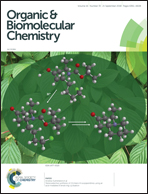Chloroform as a carbon monoxide source in palladium-catalyzed synthesis of 2-amidoimidazo[1,2-a]pyridines†
Abstract
A palladium-catalyzed aminocarbonylation strategy exploiting chloroform as a CO source has been developed for the synthesis of biologically potent 2-amidoimidazopyridine scaffolds. The aminocarbonylation reaction was found to be general with a range of amines and substituted imidazopyridines. Preliminary biological evaluation of cytotoxicity on selected examples provides scope for future investigations.
![Graphical abstract: Chloroform as a carbon monoxide source in palladium-catalyzed synthesis of 2-amidoimidazo[1,2-a]pyridines](/en/Image/Get?imageInfo.ImageType=GA&imageInfo.ImageIdentifier.ManuscriptID=C8OB01486H&imageInfo.ImageIdentifier.Year=2018)
- This article is part of the themed collection: Synthetic methodology in OBC


 Please wait while we load your content...
Please wait while we load your content...